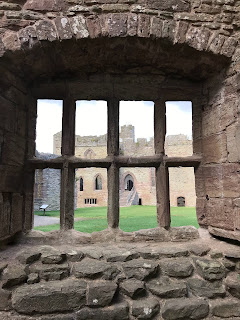Built on a rocky outcrop overlooking the River Teme, Ludlow Castle was started by Walter de Lacey who died in 1085. The family lost possession after a series of rebellions against William II.
During the 19-year anarchy ‘when Christ and his saints slept,’ Gilbert de Lacy took advantage of the chaos by siding with Matilda against King Stephen, seizing back the castle while he had the chance. Stephen marched his army into Ludlow, risking his life to save Prince Henry of Scotland. The unfortunate prince had been caught by a grappling hook and was being hauled up the walls of the castle by its defenders. King Stephen leapt on him and dragged the young prince free as battle raged about them, and in 1139 regained Ludlow Castle.
The castle was eventually returned to the Lacy family but in the early C14th fell into the hands of the powerful Mortimer dynasty
Chapel interior. The walls show where a first floor balcony would have been laid for those too important to hear Mass with the rabble.
During the C12th the round Norman chapel was built in the inner Bailey, and the castle extended to form a large outer bailey surrounded by a curtain wall. The main gatehouse is on the east curtain wall facing a growing town. To the west of the curtain wall is Mortimer’s tower, a smaller gatehouse. The Keep , well and the important Northern Range are top left.
The Keep from the inner bailey and the flag of St George. I need to get up there.
That's me up their waving down. My wife had more sense. I was reliving my childhood.
In terms of famous deaths, Edward’s two young sons, Edward Prince of Wales and Richard Duke of York were brought up there before being taken into ‘protection’ by their uncle, infamous Richard III. They disappeared soon after in the Tower of London.
Arthur, a later Prince of Wales enjoyed married life with Catherine of Aragon in Ludlow, before his premature death in 1502. The excitement proved to much for the fifteen year old boy who'd boasted that he had 'been in Spain.' His heart, (a euphemism for his bowels) is buried in St Lawrence Church, as seen from the top of the keep.
More specifically here:
Close to the High Alter
But back to the castle.
In the C16th Ludlow Castle became the administrative centre of The Council of Wales and the Marches, which met in the Great Hall. A new ‘Judge’s Lodgings’ was built near the entrance to the Inner Bailey, with a first floor bridge connecting it to the round chapel.
And the round chapel that once had a connecting bridge to the Judge's Lodgings
In the Civil War, it surrendered to the Roundheads and fell into disuse after the Council of Wales was abolished in 1689.
As for us? We ended our stay in a very nice tea-room with Earl Grey and a bun.
Carvell's—it was like stepping into an Agatha Christie

























No comments:
Post a Comment